Page 141 of 304
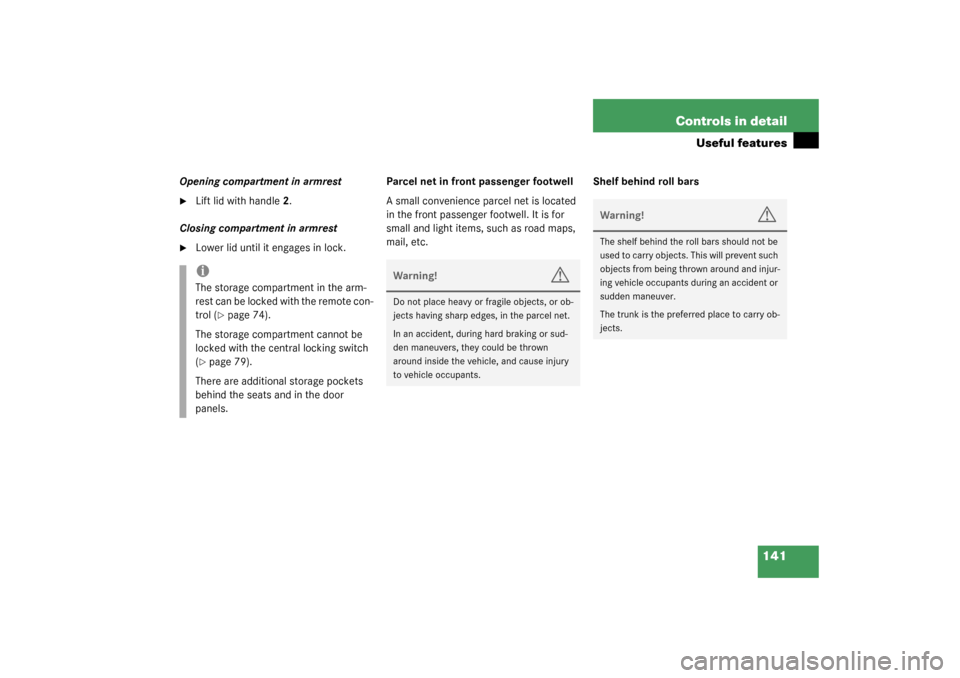
141 Controls in detail
Useful features
Opening compartment in armrest�
Lift lid with handle2.
Closing compartment in armrest
�
Lower lid until it engages in lock.Parcel net in front passenger footwell
A small convenience parcel net is located
in the front passenger footwell. It is for
small and light items, such as road maps,
mail, etc.Shelf behind roll barsiThe storage compartment in the arm-
rest can be locked with the remote con-
trol (
�page 74).
The storage compartment cannot be
locked with the central locking switch
(
�page 79).
There are additional storage pockets
behind the seats and in the door
panels.
Warning!
G
Do not place heavy or fragile objects, or ob-
jects having sharp edges, in the parcel net.
In an accident, during hard braking or sud-
den maneuvers, they could be thrown
around inside the vehicle, and cause injury
to vehicle occupants.
Warning!
G
The shelf behind the roll bars should not be
used to carry objects. This will prevent such
objects from being thrown around and injur-
ing vehicle occupants during an accident or
sudden maneuver.
The trunk is the preferred place to carry ob-
jects.
Page 143 of 304
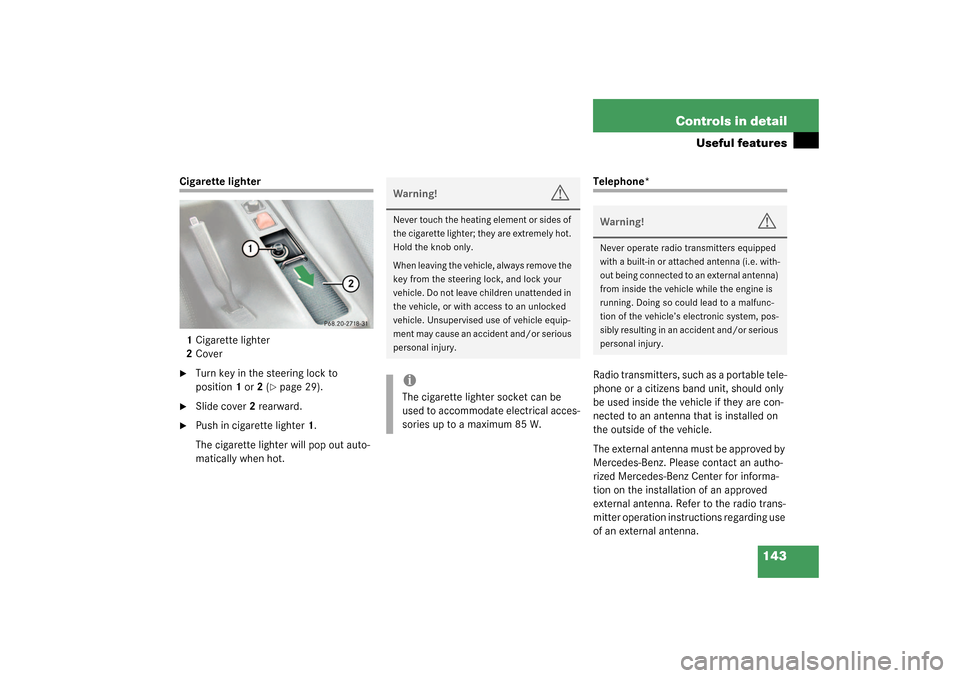
143 Controls in detail
Useful features
Cigarette lighter
1Cigarette lighter
2Cover�
Turn key in the steering lock to
position1 or2 (
�page 29).
�
Slide cover2 rearward.
�
Push in cigarette lighter1.
The cigarette lighter will pop out auto-
matically when hot.
Telephone*
Radio transmitters, such as a portable tele-
phone or a citizens band unit, should only
be used inside the vehicle if they are con-
nected to an antenna that is installed on
the outside of the vehicle.
The external antenna must be approved by
Mercedes-Benz. Please contact an autho-
rized Mercedes-Benz Center for informa-
tion on the installation of an approved
external antenna. Refer to the radio trans-
mitter operation instructions regarding use
of an external antenna.
Warning!
G
Never touch the heating element or sides of
the cigarette lighter; they are extremely hot.
Hold the knob only.
When leaving the vehicle, always remove the
key from the steering lock, and lock your
vehicle. Do not leave children unattended in
the vehicle, or with access to an unlocked
vehicle. Unsupervised use of vehicle equip-
ment may cause an accident and/or serious
personal injury.iThe cigarette lighter socket can be
used to accommodate electrical acces-
sories up to a maximum 85 W.
Warning!
G
Never operate radio transmitters equipped
with a built-in or attached antenna (i.e. with-
out being connected to an external antenna)
from inside the vehicle while the engine is
running. Doing so could lead to a malfunc-
tion of the vehicle’s electronic system, pos-
sibly resulting in an accident and/or serious
personal injury.
Page 164 of 304
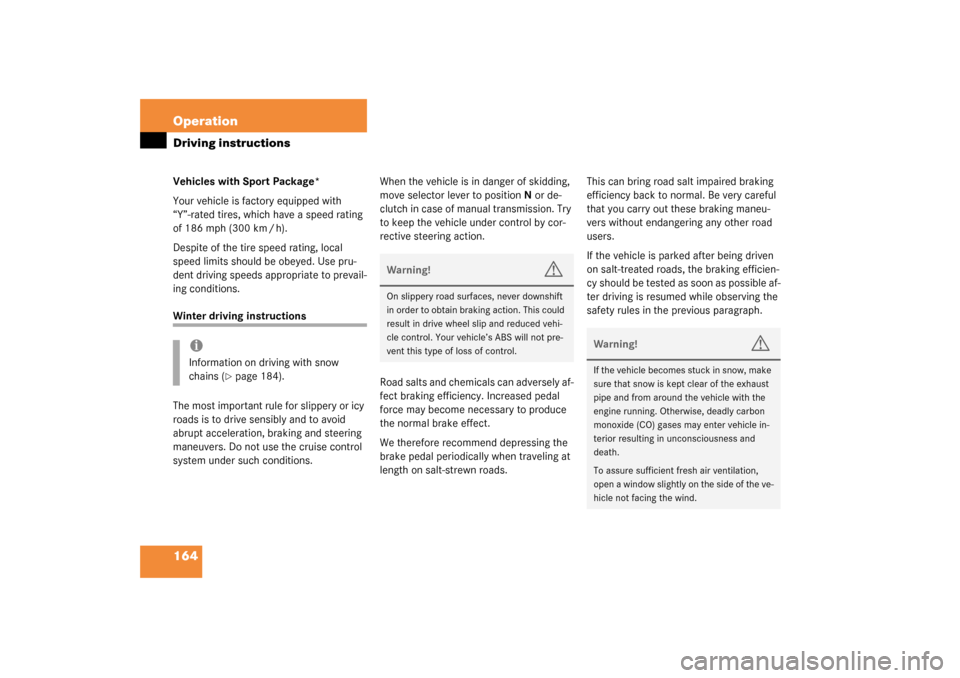
164 OperationDriving instructionsVehicles with Sport Package*
Your vehicle is factory equipped with
“Y”-rated tires, which have a speed rating
of 186 mph (300 km / h).
Despite of the tire speed rating, local
speed limits should be obeyed. Use pru-
dent driving speeds appropriate to prevail-
ing conditions.Winter driving instructions
The most important rule for slippery or icy
roads is to drive sensibly and to avoid
abrupt acceleration, braking and steering
maneuvers. Do not use the cruise control
system under such conditions.When the vehicle is in danger of skidding,
move selector lever to positionN or de-
clutch in case of manual transmission. Try
to keep the vehicle under control by cor-
rective steering action.
Road salts and chemicals can adversely af-
fect braking efficiency. Increased pedal
force may become necessary to produce
the normal brake effect.
We therefore recommend depressing the
brake pedal periodically when traveling at
length on salt-strewn roads. This can bring road salt impaired braking
efficiency back to normal. Be very careful
that you carry out these braking maneu-
vers without endangering any other road
users.
If the vehicle is parked after being driven
on salt-treated roads, the braking efficien-
cy should be tested as soon as possible af-
ter driving is resumed while observing the
safety rules in the previous paragraph.
iInformation on driving with snow
chains (
�page 184).
Warning!
G
On slippery road surfaces, never downshift
in order to obtain braking action. This could
result in drive wheel slip and reduced vehi-
cle control. Your vehicle’s ABS will not pre-
vent this type of loss of control.
Warning!
G
If the vehicle becomes stuck in snow, make
sure that snow is kept clear of the exhaust
pipe and from around the vehicle with the
engine running. Otherwise, deadly carbon
monoxide (CO) gases may enter vehicle in-
terior resulting in unconsciousness and
death.
To assure sufficient fresh air ventilation,
open a window slightly on the side of the ve-
hicle not facing the wind.
Page 173 of 304
173 Operation
Engine compartment
You can check the engine oil level with
the oil dipstick�
Open the hood (
�page 171).
�
Pull out oil dipstick1 (
�page 175) and
wipe the tip clean.
�
Reinsert the oil dipstick into the dip-
stick guide tube as far as it will go.
1Oil dipstick
�
Pull out the oil dipstick again after
approximately 3 seconds.
The oil level is acceptable when it
leaves a line between the upper and
lower marks of the dipstick.
For adding oil (
�page 175).
See “Practical hints” (
�page 200) if the
low engine oil level warning lamp in the in-
strument cluster lights up.You can check the engine oil level on the
odometer display (SLK 320 and
SLK 32 AMG only)
�
Turn the key in the steering lock to
position2.
1Knob
�
Wait until the symbols
:
and
I
appear in the odometer display indica-
tor.
iFill quantity between upper and lower
dipstick marking level is approximately
2.1 US qt (2.0 l).
��
Page 174 of 304
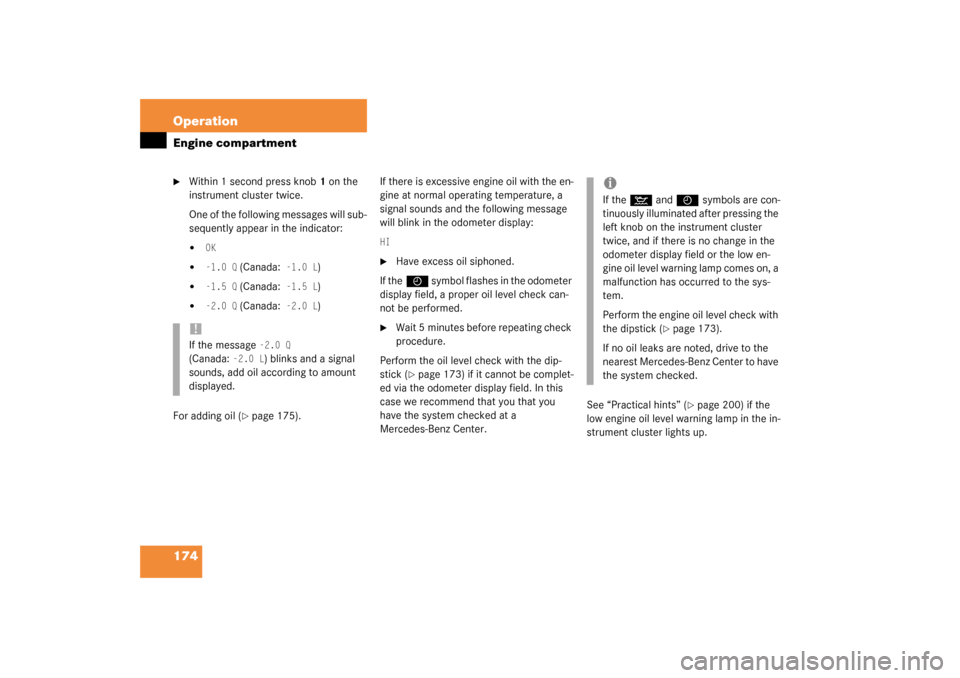
174 OperationEngine compartment�
Within 1 second press knob1 on the
instrument cluster twice.
One of the following messages will sub-
sequently appear in the indicator:�
OK
�
-1.0 Q
(Canada:
-1.0 L
)
�
-1.5 Q
(Canada:
-1.5 L
)
�
-2.0 Q
(Canada:
-2.0 L
)
For adding oil (
�page 175).If there is excessive engine oil with the en-
gine at normal operating temperature, a
signal sounds and the following message
will blink in the odometer display:
HI�
Have excess oil siphoned.
If theI
symbol flashes in the odometer
display field, a proper oil level check can-
not be performed.
�
Wait 5 minutes before repeating check
procedure.
Perform the oil level check with the dip-
stick (
�page 173) if it cannot be complet-
ed via the odometer display field. In this
case we recommend that you that you
have the system checked at a
Mercedes-Benz Center.See “Practical hints” (
�page 200) if the
low engine oil level warning lamp in the in-
strument cluster lights up.
!If the message
-2.0 Q
(Canada:
-2.0 L
) blinks and a signal
sounds, add oil according to amount
displayed.
iIf the
:
and
I
symbols are con-
tinuously illuminated after pressing the
left knob on the instrument cluster
twice, and if there is no change in the
odometer display field or the low en-
gine oil level warning lamp comes on, a
malfunction has occurred to the sys-
tem.
Perform the engine oil level check with
the dipstick (
�page 173).
If no oil leaks are noted, drive to the
nearest Mercedes-Benz Center to have
the system checked.
Page 181 of 304
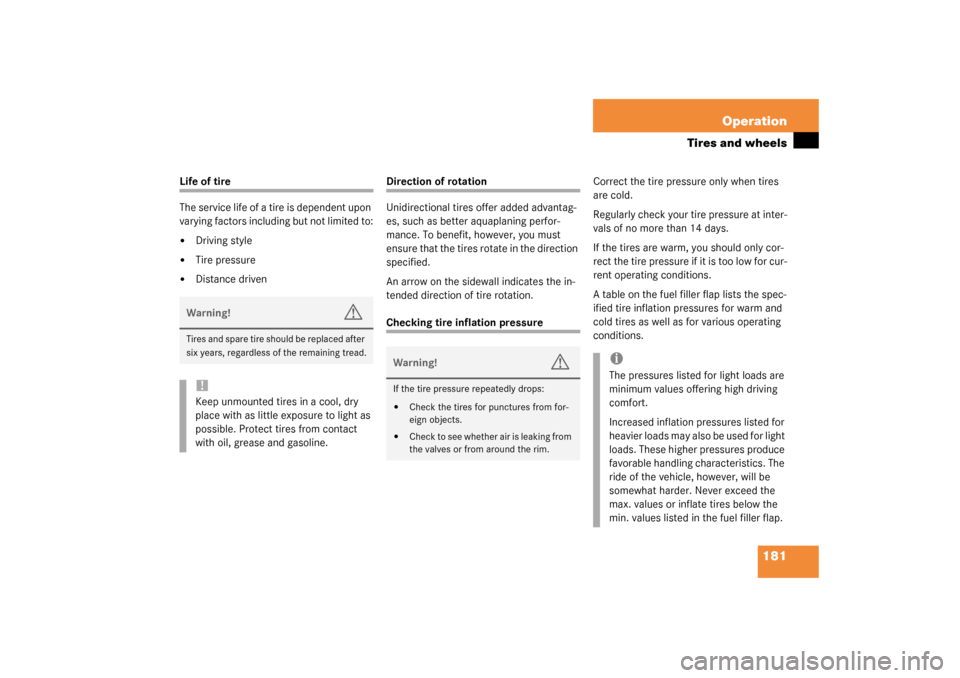
181 Operation
Tires and wheels
Life of tire
The service life of a tire is dependent upon
varying factors including but not limited to:�
Driving style
�
Tire pressure
�
Distance driven
Direction of rotation
Unidirectional tires offer added advantag-
es, such as better aquaplaning perfor-
mance. To benefit, however, you must
ensure that the tires rotate in the direction
specified.
An arrow on the sidewall indicates the in-
tended direction of tire rotation.Checking tire inflation pressureCorrect the tire pressure only when tires
are cold.
Regularly check your tire pressure at inter-
vals of no more than 14 days.
If the tires are warm, you should only cor-
rect the tire pressure if it is too low for cur-
rent operating conditions.
A table on the fuel filler flap lists the spec-
ified tire inflation pressures for warm and
cold tires as well as for various operating
conditions.
Warning!
G
Tires and spare tire should be replaced after
six years, regardless of the remaining tread.!Keep unmounted tires in a cool, dry
place with as little exposure to light as
possible. Protect tires from contact
with oil, grease and gasoline.
Warning!
G
If the tire pressure repeatedly drops:�
Check the tires for punctures from for-
eign objects.
�
Check to see whether air is leaking from
the valves or from around the rim.
iThe pressures listed for light loads are
minimum values offering high driving
comfort.
Increased inflation pressures listed for
heavier loads may also be used for light
loads. These higher pressures produce
favorable handling characteristics. The
ride of the vehicle, however, will be
somewhat harder. Never exceed the
max. values or inflate tires below the
min. values listed in the fuel filler flap.
Page 192 of 304
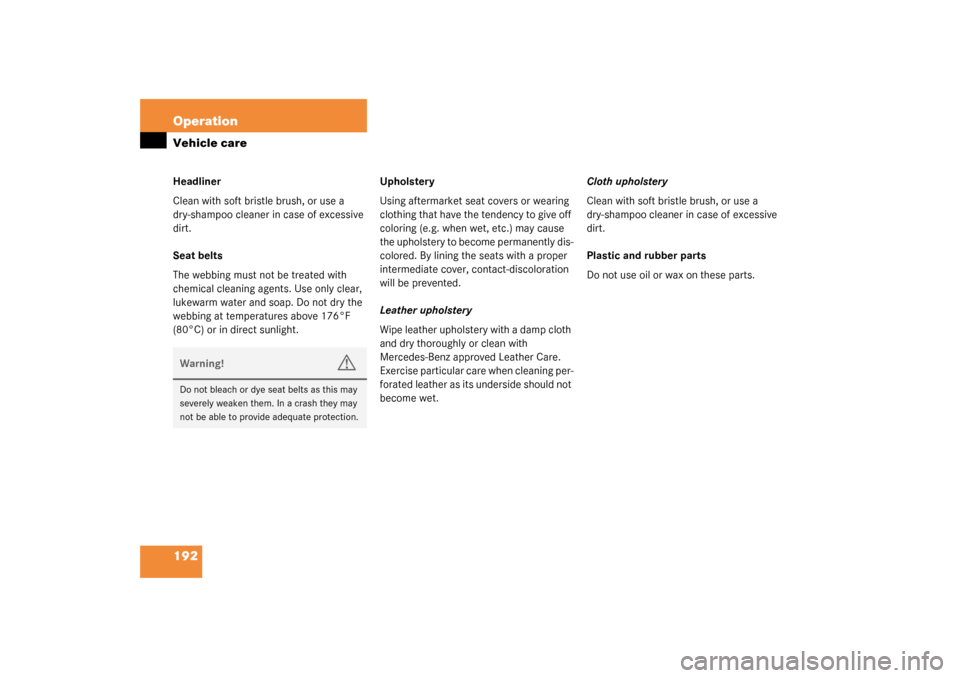
192 OperationVehicle careHeadliner
Clean with soft bristle brush, or use a
dry-shampoo cleaner in case of excessive
dirt.
Seat belts
The webbing must not be treated with
chemical cleaning agents. Use only clear,
lukewarm water and soap. Do not dry the
webbing at temperatures above 176°F
(80°C) or in direct sunlight.Upholstery
Using aftermarket seat covers or wearing
clothing that have the tendency to give off
coloring (e.g. when wet, etc.) may cause
the upholstery to become permanently dis-
colored. By lining the seats with a proper
intermediate cover, contact-discoloration
will be prevented.
Leather upholstery
Wipe leather upholstery with a damp cloth
and dry thoroughly or clean with
Mercedes-Benz approved Leather Care.
Exercise particular care when cleaning per-
forated leather as its underside should not
become wet.Cloth upholstery
Clean with soft bristle brush, or use a
dry-shampoo cleaner in case of excessive
dirt.
Plastic and rubber parts
Do not use oil or wax on these parts.Warning!
G
Do not bleach or dye seat belts as this may
severely weaken them. In a crash they may
not be able to provide adequate protection.
Page 194 of 304
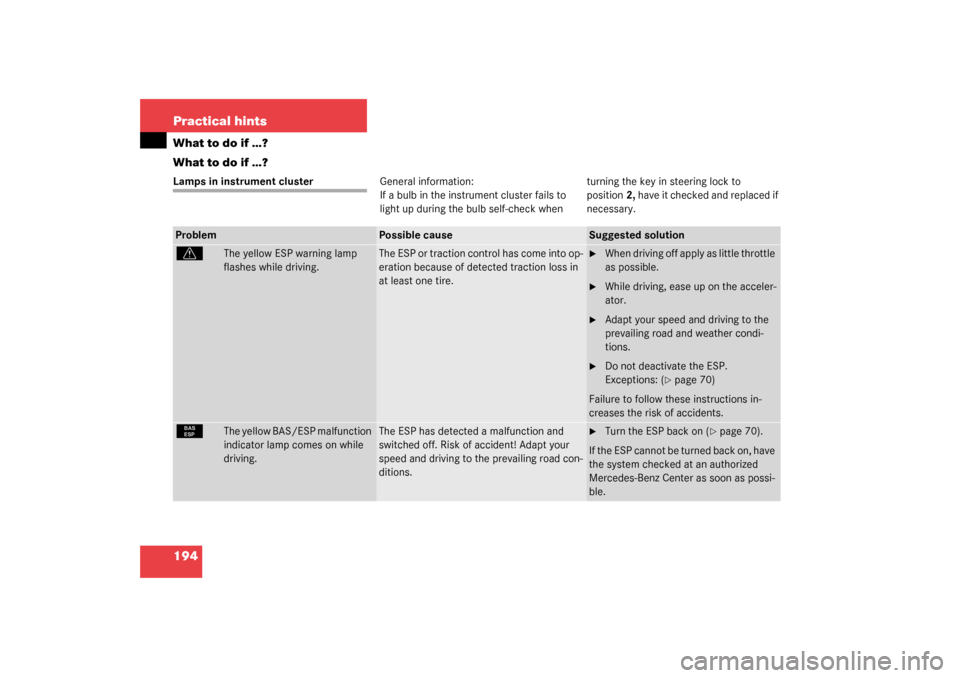
194 Practical hintsWhat to do if …?
What to do if …?Lamps in instrument clusterGeneral information:
If a bulb in the instrument cluster fails to
light up during the bulb self-check when turning the key in steering lock to
position2, have it checked and replaced if
necessary.Problem
Possible cause
Suggested solution
v
The yellow ESP warning lamp
flashes while driving.
The ESP or traction control has come into op-
eration because of detected traction loss in
at least one tire.
�
When driving off apply as little throttle
as possible.
�
While driving, ease up on the acceler-
ator.
�
Adapt your speed and driving to the
prevailing road and weather condi-
tions.
�
Do not deactivate the ESP.
Exceptions: (
�page 70)
Failure to follow these instructions in-
creases the risk of accidents.
¿
The yellow BAS/ESP malfunction
indicator lamp comes on while
driving.
The ESP has detected a malfunction and
switched off. Risk of accident! Adapt your
speed and driving to the prevailing road con-
ditions.
�
Turn the ESP back on (
�page 70).
If the ESP cannot be turned back on, have
the system checked at an authorized
Mercedes-Benz Center as soon as possi-
ble.